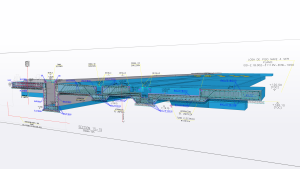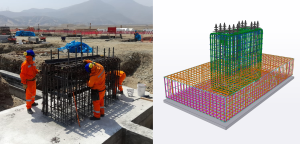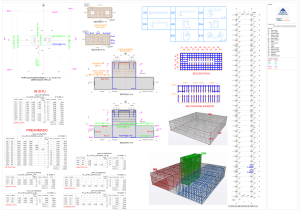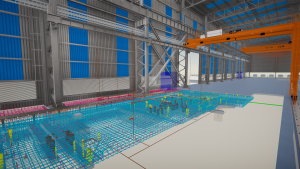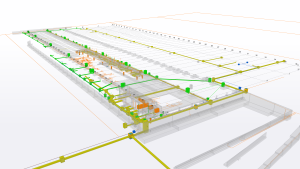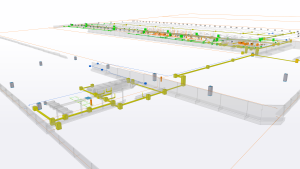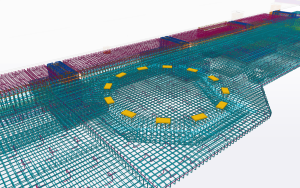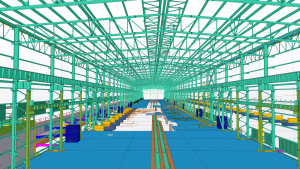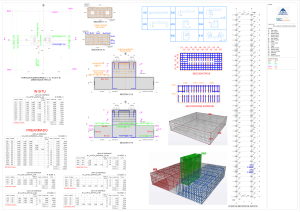CENTRO DE DISTRIBUCIÓN LURIN
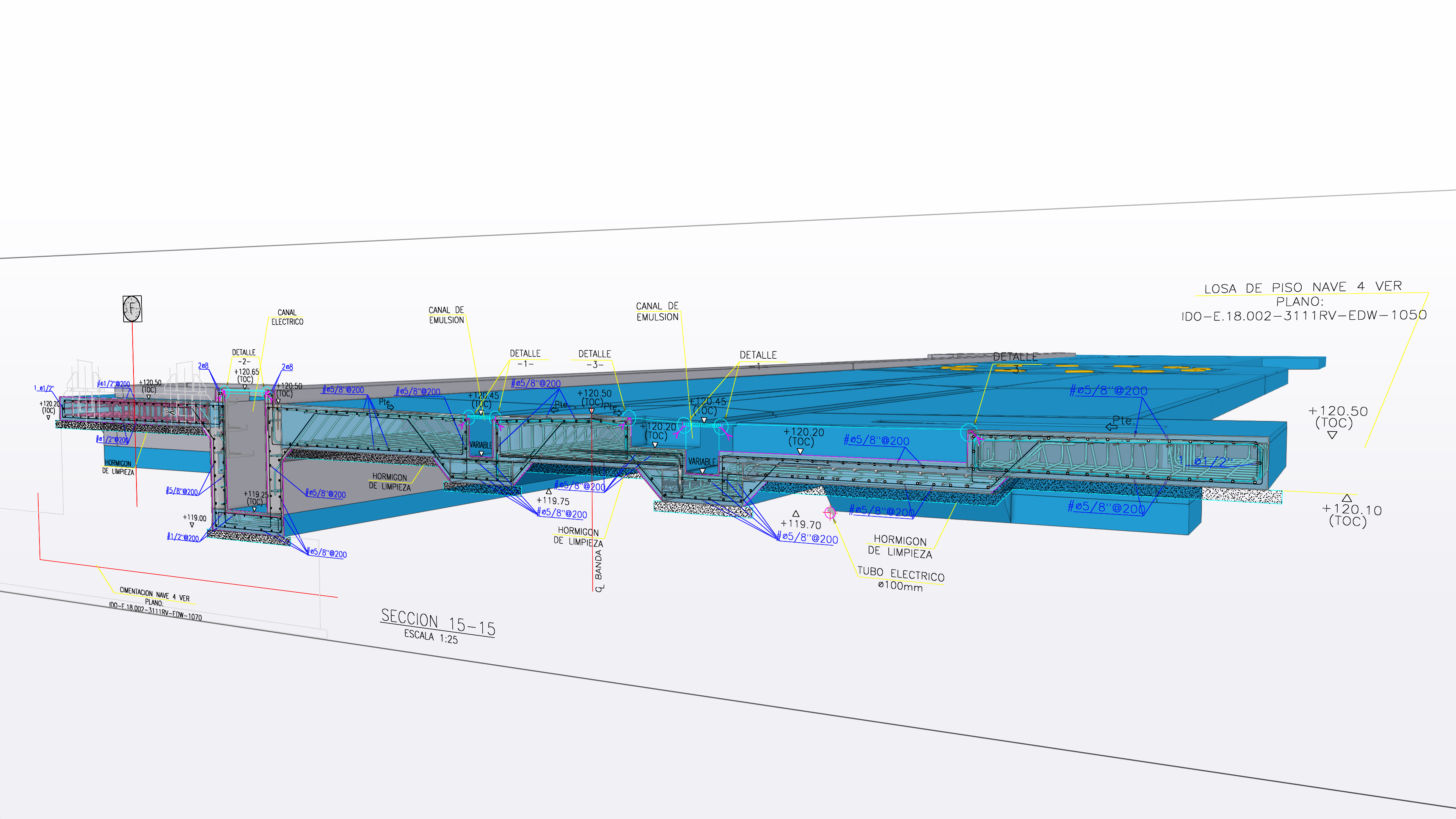
| Kategória | Ipari projektek |
|---|---|
| Év | 2023 |
| Ország | Peru |
| Szervezet | TSC INNOVATION |
| Projektpartnerek | ACEROS AREQUIPA / METALIKAS |
| Szerző | Adriana Espinoza Oliveros |
| Társszerzők | Equipo Gestión BIM - TSC Innovation |
| Ügyfél | CAFISAC |
| Az építmény helye | Lurín, Lima, Perú |
| Tags |
El proyecto del Centro de Distribución de Lurín ubicado en Lima, Perú, es una edificación industrial que alberga la línea de producción de perfiles y tubos metálicos perteneciente a la compañía ACEROS AREQUIPA. Este proyecto inició su ejecución en febrero del 2022 y actualmente ha finalizado su primera etapa. El proyecto de modelado se realizó a la par de la construcción en la cual el objetivo principal fue ejecutar a tiempo las obras civiles y estructuras metálicas de la Nave N°4 y la primera línea de producción de tubos. Se suministró un peso de alrededor de 1.20 ton de acero para estructuras de concreto armado y casi el 50% de esto se realizó como pre-armado.
El objetivo principal de utilizar modelos BIM realizados en Tekla Structures fue poder optimizar los tiempos de ejecución industrializando la construcción de estructuras metálicas y de concreto armado. Para las estructuras de concreto armado, que fueron alcance de TSC, el modelo se utilizó para la fabricación de acero pre-dimensionado y armaduras pre-armadas, con lo cual se logró reducir el tiempo de ejecución de las cimentaciones de la nave en un mes. Los modelos trabajados por TSC en Tekla Structures se encuentran completamente integrados al proceso de fabricación e instalación de acero dimensionado, estos se elaboran con parámetros personalizados los cuales nos permiten vincular la información del modelo con las planillas de producción para planta y los planos de detalle que sirven a los operarios para instalar en obra. Esto nos permite mantener una trazabilidad entre cada entregable que se trabaja a partir del modelo.
Sumado a lo anterior, se realizó una coordinación entre el modelo de concreto armado, el modelo de estructura metálica y los modelos de especialidades, integrándolos en formato IFC a la plataforma Trimble Connect. La plataforma Trimble Connect sirvió de principal herramienta de coordinación, no solamente para visualización de modelos e interferencias sino también para colaboración entre todos los actores del proyecto a través de TODOS. De esta manera, se logró agilizar la respuesta a consultas y se evitaron retrabajos en obra, debido a que se adelantaron muchas de las variables constructivas las cuales no suelen verse durante la etapa de diseño. También fue posible llevar la herramienta de Trimble AR a obra, la cual se utilizó para verificar algunos elementos en campo versus lo modelado, esto fue posible gracias al nivel de detalle que se empleó en el modelado.
Consideramos que la clave del éxito del proyecto se debió a que el modelo sirvió como medio de comunicación, colaboración e integración entre todas las partes involucradas del proyecto.
The Lurín Distribution Center project located in Lima, Peru, is an industrial building that houses the production line of metal profiles and tubes that belongs to the company ACEROS AREQUIPA. This project began its execution in February 2022 and its first stage has currently finished. The modeling project was carried out at the same time as construction, in which the main objective was to execute, on time, the civil works and metal structures of Warehouse N°4 and the first tube production line. A weight of around 1.20 tons of rebar was supplied for reinforced concrete structures and almost 50% of this was done as pre-assembled.
The main objective of using BIM models made in Tekla Structures was to be able to optimize execution times by industrializing the construction of metal and reinforced concrete structures. For the concrete structures, the model was used to manufacture pre-dimensioned and pre-assembled rebar, with this it was possible to reduce the execution time of the foundations of the warehouse in one month. The models made by TSC in Tekla Structures are fully integrated into the manufacturing and installation process of dimensioned steel, these are made with personalized attributes which allow us to link the model information with the production sheets for plant and the shop drawings that are used by operators to install on site. This enables us to maintain traceability between each submittal that is generated from the model.
It’s important to notice that there was a coordination carried out between the reinforced concrete model, the metallic structure model, and the specialties models, which were integrated in IFC format to the Trimble Connect platform. The Trimble Connect platform served as the main coordination tool, not only for model and interference visualization but also for collaboration between all project stakeholders. In this way, we were able to accelerate the response to queries and avoid rework on site, since many of the construction variables omitted on the design stage were brought before the execution works. It was also possible to take the Trimble AR tool to the site, which was used to verify some elements in the field versus what was modeled, this was possible thanks to the level of detail used in the modeling.
We believe that the key to the success of the project was because the model served as a means of communication, collaboration, and integration between all the parties involved in the project.
